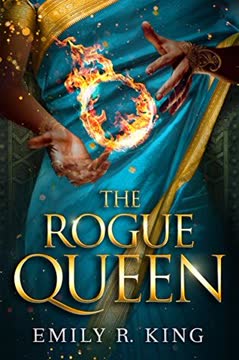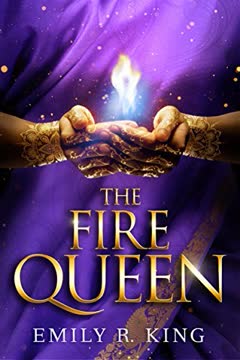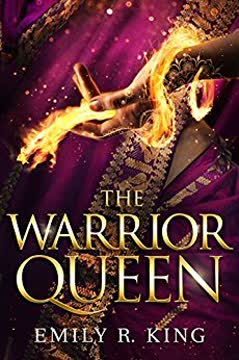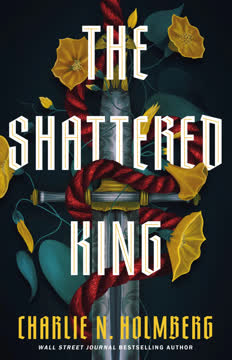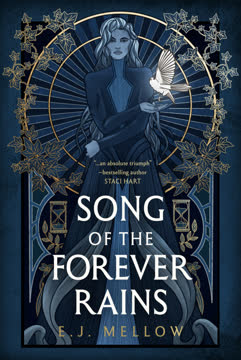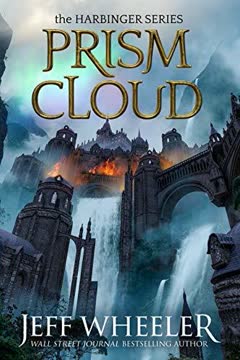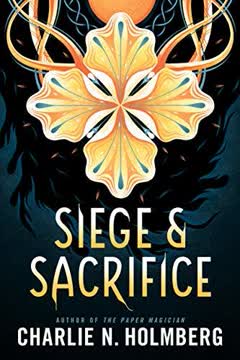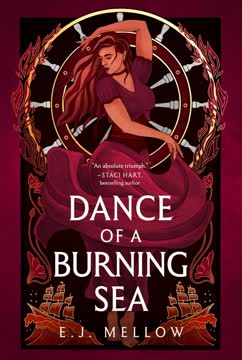Plot Summary
River Farewell and Fractures
The story opens with Kalinda and her companions laying Brother Shaan to rest on the river, a moment heavy with grief and guilt. The group, fleeing the chaos of Iresh, is fractured by loss and uncertainty. Kalinda, still recovering from her injuries and the demon's cold-fire, feels the weight of her destiny as kindred and the tension between her love for Deven and her duty to Ashwin. The journey to Lestari is both a physical and emotional crossing, as old wounds and new alliances begin to form. The river's constancy contrasts with the instability of their world, foreshadowing the turbulent path ahead.
Lestari: Alliances and Tensions
Welcomed by Admiral Rimba and Datu Bulan, Kalinda's party enters the dazzling Southern Isles. The city's beauty belies the political undercurrents: Bulan's support hinges on Kalinda's supposed betrothal to Ashwin, a fiction that strains her relationship with Deven. The group is introduced to Princess Gemi, whose independence and ambition mirror Kalinda's own. Amidst the splendor, Kalinda's inner chill persists, a reminder of the demon's lingering poison. The Lestarians' unity of bhutas and mortals offers hope, but also highlights the divisions and prejudices Kalinda must overcome within herself and her companions.
Storms, Raiders, and Rivalries
A sudden storm and a violent attack by sea raiders test the group's resolve and Kalinda's powers, now tinged with unnatural green and blue. The confrontation exposes the price on Kalinda and Ashwin's heads, set by the demon rajah, and the lengths their enemies will go to capture them. The aftermath deepens the rift between Deven and Ashwin, as both vie for Kalinda's loyalty and affection. The threat of betrayal and the uncertainty of their alliances loom large, setting the stage for further conflict as they seek support against the demon's growing army.
The Datu's Bargain
Datu Bulan's hospitality comes with strings attached: his navy's aid is contingent on Kalinda's continued role as Ashwin's intended. The group navigates courtly intrigue, with Indah and Pons' forbidden love paralleling Kalinda's own struggles. Supper with the datu reveals the depth of mistrust toward Ashwin, whose release of the Voider is seen as an unforgivable sin. The need for unity is clear, but personal desires and old wounds threaten to undermine their cause. Kalinda's sense of isolation grows, as she is forced to choose between love, duty, and survival.
Shadows, Secrets, and Betrayals
Kalinda is visited by the ghostly presence of Tarek, her abusive former husband, who warns her of dangers ahead. The encounter dredges up trauma, healing, and forgiveness and guilt, while Ashwin's comfort blurs the lines between friendship and something deeper. Deven's jealousy and sense of betrayal reach a breaking point, leading to a painful confrontation. The group is further divided as news arrives of the demon's army advancing and the need to seek an alliance with the rebel warlord, Hastin. The cost of secrets and the burden of leadership weigh heavily on Kalinda as she prepares to return to her childhood temple.
Partings and Pursuits
The group divides: Deven, Yatin, Natesa, and Rohan set out to find missing family, while Kalinda, Ashwin, Indah, and Pons fly to Samiya to negotiate with the rebels. Mathura's revelations about Brac's parentage add another layer of complexity. The pain of separation is acute, especially for Kalinda and Deven, whose unresolved feelings threaten to become permanent. Each party faces peril: Deven's group tracks the demon's army through treacherous terrain, while Kalinda's party races against time and the poison in her veins. The sense of impending doom is palpable as each path leads toward confrontation.
Return to Samiya
Kalinda's return to the Samiya temple is fraught with memories of loss and betrayal. The temple, now a place of scarcity and suspicion, is ill-prepared for the coming storm. Kalinda's attempts to reform the oppressive Claiming ritual meet resistance from Priestess Mita, exposing the deep roots of tradition and trauma, healing, and forgiveness. Ashwin's research into the Void and the demon's origins offers a glimmer of hope, but the alliance with Hastin is uncertain. The cold-fire within Kalinda worsens, and her reliance on Ashwin's soul-fire becomes both a comfort and a curse.
The Demon's March
Deven's group infiltrates the demon's swelling army, witnessing firsthand the horrors of Udug's power as he feeds on bhuta soul-fire. The cost of war becomes personal with the loss of Rohan, and the group's unity is tested by grief and guilt. Meanwhile, Kalinda's negotiations with Hastin's daughter, Anjali, turn violent, resulting in the destruction of the Samiya temple by Kalinda's uncontrollable nature-fire. Exiled and blamed, Kalinda and her companions are forced to flee, their hopes for alliance in ruins. The demon's march toward Vanhi accelerates, and the shadow of the Void grows ever darker.
Homecoming and Haunted Memories
The survivors of the temple fire are rescued by Paljorian allies, but Kalinda's guilt and the poison within her deepen her isolation. The group is scattered: Deven and his friends are captured by the demon's forces, while Kalinda, Ashwin, and Gemi race to Vanhi, pursued by both enemies and their own inner demons. The siege of Vanhi begins, with the rebels and sister warriors preparing for a last stand. The cost of leadership, the weight of the past, and the hope for redemption drive each character toward the coming battle.
Infiltration and Loss
Deven and his friends, imprisoned and tortured, witness the demon's cruelty and the futility of resistance. Natesa's courage and Yatin's loyalty are tested as they risk everything to free their friends. The siege of Vanhi is marked by treachery and loss, as the rebels' defenses are breached and the city falls into chaos. Kalinda's arrival is too late to prevent tragedy, but her presence inspires the sister warriors to fight. The cost of victory is high, and the line between friend and foe blur as the true enemy reveals himself.
The Claiming's Legacy
Kalinda's confrontation with the legacy of the Claiming ritual becomes a turning point. She and Ashwin finally acknowledge the truth of their bond: Ashwin's heart's wish has bound Kalinda to him, distorting her feelings and fate. The revelation is both liberating and devastating, as Kalinda reclaims her agency and chooses Deven. The palace becomes a battleground, not just for the empire, but for the soul of its people. The cost of breaking free from the past is steep, but Kalinda's resolve to end the cycle of oppression and violence is unshakable.
The Warlord's Ultimatum
With the demon's army at the gates, Hastin and the rebels are forced to ally with Kalinda and Ashwin. The sister warriors, once rivals, now stand united against a common enemy. The battle for Vanhi is fierce and chaotic, with magic and steel clashing in the storm. Udug's true form is revealed, and the cost of victory becomes clear: only by banishing the demon through the gate to the Void can the world be saved. Sacrifices are made, and the line between hero and monster blurs as Kalinda embraces the darkness within her to fight for the light.
Fire and Exile
Udug's defeat comes at a terrible price. His true form, monstrous and immortal, is only driven back, not destroyed. The cost is personal: Deven is lost to the Void, and Kalinda is left maimed and haunted. The survivors mourn their dead and begin the work of rebuilding, but the scars of war run deep. The legacy of the sister warriors is secured, and the oppressive rituals of the past are abolished. Yet, the threat of the evernight lingers, and the hope for true peace remains fragile.
Desert March and Deceptions
As the sun is eclipsed and the world darkens, Kalinda and her allies race to the mountains to confront Udug at the gate to the Void. The journey is perilous, marked by betrayal, sacrifice, and the ever-present threat of the demon's kin. The final battle looms, and each character must confront their deepest fears and desires. The cost of victory is uncertain, and the fate of the world hangs in the balance as the forces of light and darkness prepare for their ultimate confrontation.
The Siege of Vanhi
The armies of mortals and bhutas, rebels and sister warriors, unite for a last stand against Udug and his demon siblings. The battle is epic battles and sacrifice and brutal, with magic and might clashing under a dying sun. Kur, the First-Ever Dragon, emerges from the Void, threatening to consume all. Kalinda, embracing both her light and darkness, leads the charge, forging alliances and making impossible choices. The cost of victory is steep, and the line between salvation and damnation blurs as the world teeters on the edge.
The Battle for the Palace
In the heart of the palace, Kalinda and her allies confront Udug and his kin in a battle that is as much spiritual as physical. The power of love, forgiveness, and sacrifice becomes the only weapon against the evernight. Deven's fate is sealed as he is dragged into the Void, and Kalinda is left to mourn and rebuild. The survivors, scarred but unbroken, begin the work of healing and forging a new future, one where choice and agency are honored above all.
The Demon Unleashed
The final confrontation at the gate to the Void is both epic and intimate. Kalinda, drawing on all her strength and the love of those she has lost, faces Kur and his siblings. The battle is won not by might, but by the power of forgiveness and the refusal to be defined by darkness. The world is saved, but at great cost: Deven is lost to the evernight, and Kalinda is left to carry on his memory. The sun returns, and with it, the hope for a new beginning.
The Gate to the Void
In the aftermath, the survivors gather to mourn and celebrate. The oppressive rituals of the past are abolished, and the sister warriors take their place as leaders and teachers. Kalinda, maimed but unbroken, finds solace in art and the promise of reunion with Deven, whose spirit lingers in the shadows. The world is forever changed, but the legacy of courage, love, and choice endures. The story ends with hope: that even in the darkest night, the light of love can guide the way home.
Characters
Kalinda
Kalinda is the heart of the story: a former orphan and temple ward, now the kindred and reluctant queen. Her journey is one of self-discovery, as she grapples with trauma, love, and the burden of leadership. The poison of the demon's cold-fire threatens her life and sanity, forcing her to rely on others—especially Ashwin and Deven—in ways that challenge her fiercely independent spirit. Her relationships are complex: she loves Deven deeply, but is bound to Ashwin by duty and magic. Kalinda's greatest struggle is with her own identity: as a Burner, a woman, and a leader. Her arc is one of embracing both her light and darkness, ultimately choosing forgiveness and agency over vengeance and fate.
Deven
Deven is Kalinda's anchor and the embodiment of steadfast loyalty. A former palace guard and now general, he is haunted by guilt over his family's suffering and his inability to protect those he loves. His relationship with Kalinda is marked by deep devotion, but also by the pain of being second to her throne and her destiny. Deven's journey is one of sacrifice: he repeatedly puts others before himself, even at the cost of his own happiness. His eventual loss to the Void is both a tragedy and a testament to his selflessness, and his lingering presence in the shadows offers hope for reunion.
Prince Ashwin
Ashwin is the young heir to the Tarachand Empire, driven by a desire to atone for his father's sins and his own role in unleashing the demon. His love for Kalinda is genuine, but complicated by the magical bond of his heart's wish, which distorts both their feelings. Ashwin's arc is one of maturation: from a sheltered, bookish youth to a ruler willing to make hard choices for his people. His struggle with guilt and the weight of leadership is central, and his ultimate willingness to let Kalinda go marks his growth. Ashwin's idealism is both his strength and his weakness, shaping the fate of the empire.
Natesa
Natesa, once a courtesan, is fiercely intelligent, resourceful, and protective of those she loves. Her relationship with Yatin is a rare source of joy and stability in a world of chaos. Natesa's pragmatism and wit often cut through tension, and her willingness to risk everything for her friends marks her as a true sister warrior. Her arc is one of transformation: from survivor to leader, and from rival to trusted ally. Natesa's insistence on agency and choice reflects the novel's central themes.
Yatin
Yatin is Deven's best friend and Natesa's beloved, a man of few words but deep loyalty. His strength is both physical and emotional, providing stability in times of crisis. Yatin's journey is quieter than others, but his steadfastness and willingness to risk himself for his friends are crucial to the group's survival. His relationship with Natesa is a model of mutual respect and support, and his acceptance of her independence is a subtle but powerful counterpoint to the story's exploration of agency.
Indah
Indah, a Southern Isles Aquifier and Virtue Guard, is both healer and warrior. Her love for Pons and her struggle with her father's expectations mirror Kalinda's own conflicts. Indah's powers are essential to the group's survival, but her true strength lies in her empathy and wisdom. Her pregnancy and eventual motherhood symbolize hope and renewal, even as she suffers loss and betrayal. Indah's arc is one of reconciliation: with her heritage, her family, and herself.
Pons
Pons, a Galer and Virtue Guard, is Indah's partner and protector. His quiet strength and unwavering support are vital to the group's cohesion. Pons' journey is one of balancing duty and love, as he navigates the expectations of his homeland and his devotion to Indah. His role as a father and his willingness to forgive and trust reflect the story's emphasis on healing and new beginnings.
Brac
Brac, Deven's half-brother and a rare Burner, is marked by years of hiding and fear. His journey is one of acceptance: of his powers, his family, and his place in the world. Brac's humor and bravado mask deep wounds, and his eventual embrace by both his family and society is a hard-won victory. His role in the final battle is crucial, and his arc underscores the novel's themes of identity and redemption.
Hastin
Hastin, the rebel leader and Trembler, is a complex antagonist-turned-ally. His hatred for the empire is rooted in personal tragedy, and his willingness to use violence and manipulation makes him both a threat and a necessary partner. Hastin's arc is one of reluctant alliance and ultimate sacrifice, as he recognizes the greater threat posed by the demon and chooses to fight for a future beyond vengeance.
Udug (The Voider)
Udug, the Voider, is the story's central antagonist: a demon unleashed from the Void, feeding on soul-fire and seeking to open the gate for his master, Kur. His ability to manipulate, corrupt, and destroy is both physical and psychological, as he preys on the weaknesses and traumas of the protagonists. Udug's true form is monstrous, but his greatest weapon is the way he forces his enemies to confront their own darkness. His defeat is hard-won, and his legacy lingers as a warning of the cost of unchecked power and hatred.
Plot Devices
Dual Narration and Shifting Perspectives
The novel employs a dual (sometimes multiple) first-person narration, primarily alternating between Kalinda and Deven. This structure allows readers to experience the story's events from both the heart of power and the front lines, deepening the emotional stakes and highlighting the personal costs of war and leadership. The shifting perspectives also serve to build tension, as secrets and misunderstandings accumulate, and to explore the psychological complexity of love, loyalty, and trauma.
Magical Realism and Symbolic Powers
The world's magic system—bhuta powers, soul-fire, and the poison of the Void—serves as both literal and symbolic plot devices. Kalinda's struggle with the demon's cold-fire is a metaphor for trauma and the fight for agency. The powers of the various bhuta types (Burners, Aquifiers, Galers, Tremblers) are used to explore themes of difference, prejudice, and the potential for both creation and destruction. The magical bond of Ashwin's heart's wish is a plot device that complicates relationships and raises questions about free will.
Foreshadowing and Prophecy
The story is rich with foreshadowing, often delivered through myths, legends, and religious texts. The tale of Inanna's Descent, the prophecy of the gate to the Void, and the recurring motifs of stars, fire, and darkness all serve to guide the characters and the reader toward the climax. These elements also reinforce the story's exploration of fate versus choice, and the power of belief to shape reality.
Trauma, Healing, and Forgiveness
The characters' journeys are marked by trauma—personal, familial, and societal. The process of healing, both magical and emotional, is central to the plot. Forgiveness, especially Kalinda's forgiveness of Tarek and herself, is the key to breaking cycles of violence and oppression. The abolition of the Claiming ritual and the forging of new alliances are narrative resolutions that reflect the story's commitment to agency, choice, and hope.
Epic Battles and Sacrifice
The novel builds toward epic battles—against the demon's army, the siege of Vanhi, and the final confrontation at the gate to the Void. These set pieces are not just spectacles, but crucibles in which characters are tested, alliances are forged or broken, and sacrifices are made. The cost of victory is always personal, and the line between hero and monster is never clear-cut.
Analysis
The Rogue Queen is a sweeping fantasy that interrogates the nature of power, agency, and healing in a world scarred by violence and oppression. At its core, the novel is about the struggle to reclaim one's destiny from the forces—both human and supernatural—that seek to define and control it. Kalinda's journey from victim to leader, from haunted survivor to agent of change, is mirrored in the transformation of the empire itself: from a society built on ritualized subjugation to one that values choice and unity. The story does not shy away from the costs of trauma, the complexity of forgiveness, or the ambiguity of love and loyalty. Its magic system is both a source of wonder and a metaphor for the wounds and gifts we carry. In the end, The Rogue Queen offers a hard-won hope: that even in the darkest night, the light of love, agency, and forgiveness can guide us home.
Last updated:
Review Summary
The Rogue Queen receives mixed reviews, with ratings ranging from 1 to 5 stars. Many readers praise the action-packed plot and character development, particularly Kalinda's growth. However, some criticize the love triangle and find the middle section slow. Readers appreciate the expanded world-building and magical elements but are divided on the ending. Several reviewers express disappointment with Kalinda's actions and decision-making. Despite some criticisms, many fans of the series remain eager for the next installment, while others feel the story has lost its appeal.
